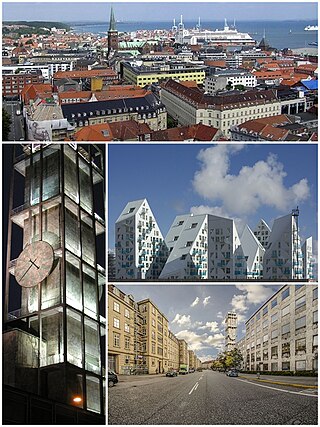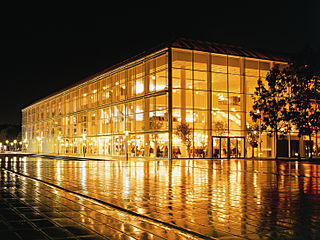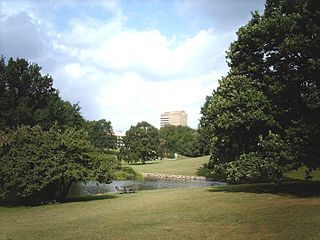
Aarhus is the second-largest city in Denmark and the seat of Aarhus Municipality. It is located on the eastern shore of Jutland in the Kattegat sea and approximately 187 kilometres (116 mi) northwest of Copenhagen.

Aarhus University is a public research university with its main campus located in Aarhus, Denmark. It is the second largest and second oldest university in Denmark. The university is part of the Coimbra Group, the Guild, and Utrecht Network of European universities and is a member of the European University Association.

ARKEN Museum of Modern Art is a state-authorised private non-profit charity and contemporary art museum in Ishøj, near Copenhagen. The museum is among Denmark's major contemporary and modern art collections, holding a variety of international cultural works and exhibitions. The museum was designed by Søren Robert Lund and was authorised by Copenhagen County. It was inaugurated on 15 March 1996 and was conceived by Queen Margrethe.

Aarhus Stadium is an association football stadium in Aarhus, Denmark which has been the home ground of Aarhus Gymnastikforening since the 1920s. With a current capacity of 19,433, it is the third largest football stadium of any football team in Denmark. It is part of the sports complex, known as Aarhus Sports Park, that is run by Ceres Park & Arena.

The ARoS Aarhus Kunstmuseum is an art museum in Aarhus, Denmark. The museum was established in 1859 and is the oldest public art museum in Denmark outside Copenhagen. On 7 April 2004, ARoS Aarhus Kunstmuseum opened with exhibitions in a brand new modern building, 10 stories tall with a total floor area of 20,700 m² and designed by Danish architects Schmidt Hammer Lassen. Today, ARoS is one of the largest art museums in Northern Europe with a total of 980,909 visitors in 2017.

Midtbyen, also known as Aarhus Center or City, is the inner part of Aarhus. Midtbyen is part of district Aarhus C, mainly with postal code 8000, together with Vesterbro, Nørre Stenbro Trøjborg and Frederiksbjerg and has a population of around 90000

Sergei Sviatchenko is a Danish-Ukrainian architect, artist, photographer and curator. He is a representative of the Ukrainian New Wave, that arose in Ukraine up through the 1980s. Initiator and creative director of the Less Festival of Collage, Viborg and Just A Few Works. He has lived in Denmark since the 1990s. Sviatchenko graduated from Kharkov National University of Construction and Architecture in 1975, and in 1986 he studied a Ph.D. at the National Academy of Visual Arts and Architecture. Sviatchenko is the son of architect Evgenij Sviatchenko (1924–2004), who was professor of architecture and a member of the National Ukrainian Academy of Fine Arts and Architecture, and engineer Ninel Sviatchenko (1926–2000). In 1975 Sergei Sviatchenko completed his architectural studies at Kharkov National University of Construction and Architecture. Sergei Sviatchenko is especially oriented towards architecture's modern expressions, among these are Constructivism and the contemporary European Bauhaus movement. From his teacher, Professor Viktor Antonov, Sviatchenko was introduced to the film director Andrei Tarkovsky, and particularly his film Mirror from 1975 has left a thematic footprint in Sviatchenko's more recent collage art. After having worked as an architect for a number of architectural firms in Kharkov until 1983, Sviatchenko moved to Kyiv, where he successfully graduated the master's program at Kyiv National University of Construction and Architecture|Kiev National University of Construction and Architecture, having completed his Ph.D. dissertation "Means to Visual Information in Architecture". In the 1980s he was one of the founders of the Soviart Center for Contemporary Art (Soviart) in Kiev and co-organizer and curator of the first Ukrainian exhibitions of contemporary art "Kiev-Tallinn" at Igor Sikorsky Kyiv Polytechnic Institute|Kiev Polytechnic Institute(1987), "Kiev-Kaunas" (1988), the first joint exhibition by Soviet and American artists (1988) and curated the first Ukrainian exhibitions in Denmark: "21 perceptions. Young Contemporary Ukrainian Artists" (1989), "Ukrainian Art 1960–80" (1990), "7 + 7" which was the first joint exhibition by Soviet and Danish artists (1990) and "Flash. A New Generation of Ukrainian Art" (1990). At the end of 1990 Sviatchenko moved to Denmark with his wife Helena Sviatchenko having been awarded an art scholarship. In the same year he began to participate in solo and group exhibitions.

Christian Frederik Møller, generally referred to as C. F. Møller, was a Danish architect, professor and, from 1965 to 1969, the first rector of the Aarhus School of Architecture. His former practice, Arkitektfirmaet C. F. Møller, which he founded in 1924, still exists and bears his name. It is today the largest architectural firm in Denmark with branch offices in several countries.

Arkitektfirmaet C. F. Møller, internationally also known as C. F. Møller Architects, is an architectural firm based in Århus, Denmark. Founded in 1924 by C. F. Møller, it is today the largest architectural firm in Denmark based on number of employed architects. About half the revenue is earned outside Denmark. Besides the main office in Århus, the firm has offices in Copenhagen, Oslo, London and in 2007 it bought the Stockholm-based Swedish architectural practice Berg Arkitekter which is still operated under its own name.

Kay Otto Fisker was a Danish architect, designer and educator. He is mostly known for his many housing projects, mainly in the Copenhagen area, and is considered a leading exponent of Danish Functionalism.

The Aarhus School of Architecture was founded in 1965 in Aarhus, Denmark. Along with the Royal Danish Academy of Fine Arts, School of Architecture in Copenhagen, it is responsible for the education of architects in Denmark. The school has approximately 750 students.
Stig Lennart Andersson usually referred to as Stig L. Andersson, is a Danish landscape architect, founder and Creative Director of Copenhagen-based SLA which has developed into an interdisciplinary organisation working with landscape, urban spaces and urban planning.

Godsbanen is a cultural centre in central Aarhus, Denmark since 2012. The site and most of the buildings are a former goods station, known as "Aarhus Godsbanegård", which was in use from 1923 to 2000. It is located at the end of a broad sidetrack to the central railway yard of Aarhus. In December 2010, Realdania announced that the area would be gradually transformed into a modern city district, through a collaborative project with Aarhus Municipality. Apart from the new cultural centre of Godsbanen, there are plans to build several buildings and institutions along the former railway yard, including a new school of architecture.

Musikhuset Aarhus is a large concert hall complex in Aarhus, Denmark. Located in the city centre, Musikhuset is Aarhus' main venue for music and with seating for more than 3,600 people in total, it is the largest concert hall in Scandinavia. Musikhuset Aarhus was designed by Kjær & Richter and built in 1979-1982, commissioned by Aarhus Municipality.
Jane Jin Kaisen is a visual artist and filmmaker based in Copenhagen, Denmark.

Århus Statsgymnasium is a secondary school and Danish Gymnasium in the neighborhood Hasle in Aarhus, Denmark. The school offers the 3 year Matriculation examination (STX) programme. It was the third Gymnasium to be built in or around Aarhus and the 38th State Gymnasium in country. The school is an independent self-owning institution under the Danish state with about 800 students divided across 30 classes.

Aarhus University Park or the University Park is a public park in central Aarhus, Denmark. The University Park is at the centre of Aarhus University's main campus.

Vester Allé 12 is a listed building in Aarhus, Denmark. The building was completed in 1902 and was listed by the Danish Heritage Agency in the Danish registry of protected buildings and places on 5 April 1988. The building is situated on the west side of Vester Allé close by Vester Allé Barracks and ARoS Aarhus Art Museum. The building has been home to some of the earliest cultural institutions in the city.

Thorkel Luplau Møller was a Danish architect who primarily worked in and around Aarhus at the turn of the 20th century. Stylistically he worked in the National Romantic style and later Baroque Revival.

The architecture of Aarhus comprises numerous architectural styles and works from the Middle Ages to present-day. Aarhus has a well-preserved medieval city center with the oldest dwellings dating back to the mid-1500s and some ecclesiastical structures such as St. Clemen's Cathedral and numerous smaller churches that can be traced back to the 1100s. The industrialization of the 19th and 20th centuries left distinctive industrial structures, important National romantic works and some of the best examples of Functionalist architecture in the country. The history of the city as a Viking fort is evidenced in the street layout of the Latin Quarter, the wider Indre By neighborhood testifies to its later role as a Market town and center of commerce while the Frederiksbjerg, Trøjborg and Marselisborg districts showcase the first cohesive urban planning efforts of the early 20th century.



















